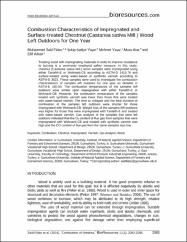Combustion Characteristics of Impregnated and Surface-treated Chestnut (Castanea sativa Mill.) Wood Left Outdoors for One Year
Access
Attribution 3.0 United Statesinfo:eu-repo/semantics/closedAccesshttp://creativecommons.org/licenses/by/3.0/us/Date
2016Access
Attribution 3.0 United Statesinfo:eu-repo/semantics/closedAccesshttp://creativecommons.org/licenses/by/3.0/us/Metadata
Show full item recordAbstract
Treating wood with impregnating materials in order to improve resistance to burning is a commonly employed safety measure. In this study, chestnut (Castanea sativa Mill.) wood samples were impregnated using either Tanalith-E or Wolmanit-CB according to ASTM-D 1413-76 and surface-treated using water-based or synthetic varnish according to ASTM-D 3023. These samples were used to investigate the combustion characteristics of samples left outdoors for one year as detailed in ASTM-E 160-50. The combustion temperatures of the samples left outdoors were similar upon impregnation with either Tanalith-E or Wolmanit-CB. However, the combustion temperature of the samples treated with synthetic varnish was lower than those that were treated with water-based varnish. The time to collapse and the total duration of combustion of the samples left outdoors were shorter for those impregnated with Wolmanit-CB. Weight loss of the samples left outdoors was higher for those that were impregnated with Tanalith-E and treated with water-based varnish. Gas analysis of the samples that were left outdoors indicated that the O-2 content of flue gas from samples that were impregnated with Wolmanit-CB and treated with synthetic varnish was high and the CO content of flue gas from the same samples was low.
Volume
11Issue
1Collections
The following license files are associated with this item:



















